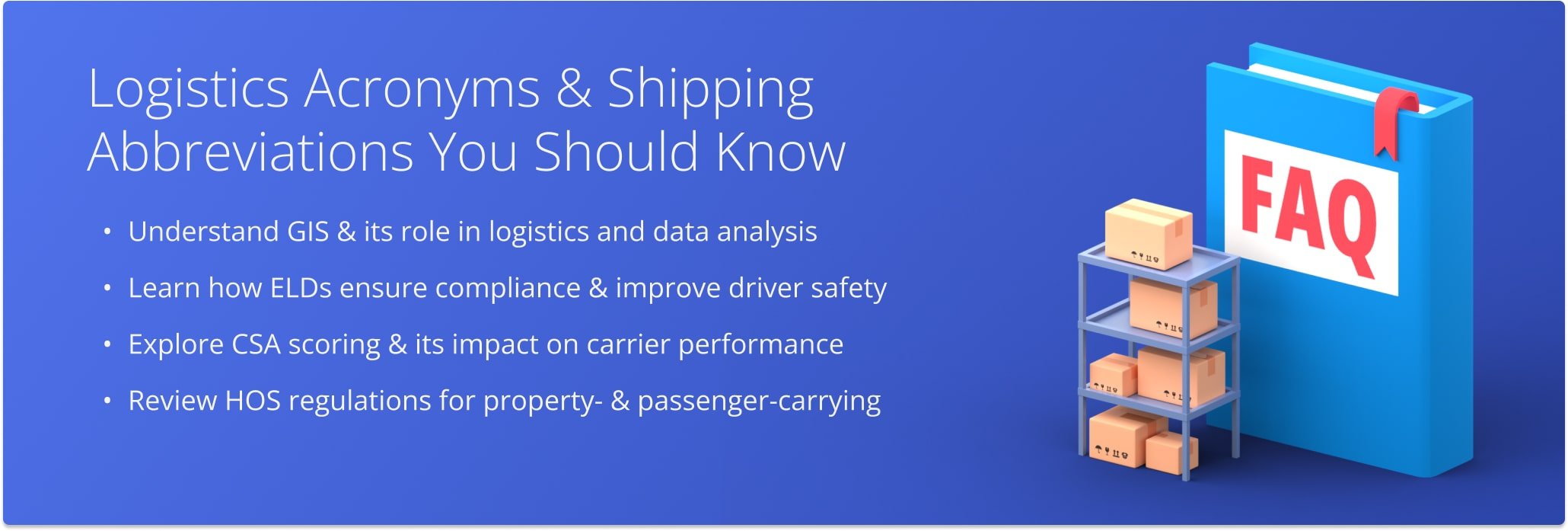Shipping Abbreviations And Logistics Acronyms
Logistics professionals and fleet managers use different shipping abbreviation variations and a lot of logistics acronyms when referring to transportation regulations and logistics processes. Here are the most common and useful logistics acronyms and transportation abbreviations:
Table of Contents
What Is GIS?
GIS is the acronym for geographic information systems, a technology that introduces spatial data into data analysis, making correlations between location data and aspatial data possible. GIS collects, analyzes, and maps data. It has applications in engineering, transportation and logistics, telecommunications, and many other fields. GIS helps identify patterns based on the relationship between geographical locations and tubular data.
What Is an ELD?
The ELDs shipping abbreviation, or E-Logs, refers to electronic logging devices that can be installed on the engine of a commercial motor vehicle to accurately keep track of professional drivers’ working hours or hours of service (HOS). Furthermore, the Federal Motor Carrier Safety Administration (FMCSA) made the use of ELDs mandatory for bus and truck drivers in 2017.
ELD’s benefits are numerous – from ensuring HOS regulations compliance and improving driver safety to saving time, reducing driver fatigue, and avoiding errors in physical, paper-based logs. Thanks to ELDs, monitoring HOS and filling in records of duty status (RODS) has become a lot easier for drivers.
FleetUp’s FMCSA-approved Intelligent ELD can help you stay compliant with the ELD mandate and HOS regulations.
What Is the CSA?
CSA is a shipping abbreviation that stands for Compliance, Safety, Accountability. CSA is a program initiated by the Federal Motor Carrier Safety Administration (FMCSA) and designed to help motor carriers and professional drivers pinpoint safety problems. The CSA system is addressed to businesses having at least one 10,000+ lbs fleet vehicle that offers interstate transportation or offers in-state hazardous materials transportation services.
To this end, CSA uses the safety measurement system (SMS), which grades motor carriers based on seven Behavior Analysis and Safety Improvement Categories (BASICs) criteria, including:
- Unsafe driving
- Hours of service (HOS) compliance
- Driver fitness
- Controlled substances and alcohol
- Vehicle maintenance
- Hazardous materials compliance
- Crash indicator
Subsequently, CSA evaluates the motor carriers based on these seven BASIC factors. Then, it gives scores on a scale of 0 to 100. In short, the lower the score, the better.
If a motor carrier’s SMS score is unsatisfactory, warnings and interventions will be carried out so that the respective organization can improve their safety record and performance.
What Is HOS?
The shipping abbreviation HOS refers to a set of regulations issued by the Federal Motor Carrier Safety Administration (FMCSA) regarding the maximum Hours of Service a professional driver is allowed to perform during a workday safely. HOS aims to reduce driver fatigue and accident risks associated with the lack of proper rest and breaks.
For example, according to FMCSA, property-carrying drivers should not drive more than 11 consecutive hours without a 10-hour break. Plus, after being off duty for 10 hours, the drivers may not drive more than 14 consecutive hours. Moreover, after 8 hours of driving, a 30-minutes break is necessary.
On the other hand, passenger-carrying drivers are allowed to drive for 10 consecutive hours following an 8-hour off-duty period of time. Furthermore, for bus drivers, the maximum number of consecutive driving hours allowed after an 8-hour break is 15.
Visit Route4Me's Marketplace to Check out Associated Modules:
- Routing Business Rules
Driver Breaks
- Routing Business Rules
Business Rule - Max Route Distance
- Operations
Advanced Team Management
Last Updated:
